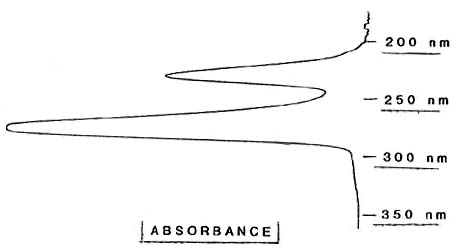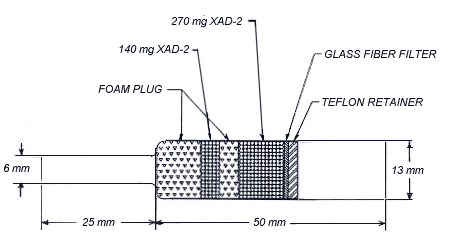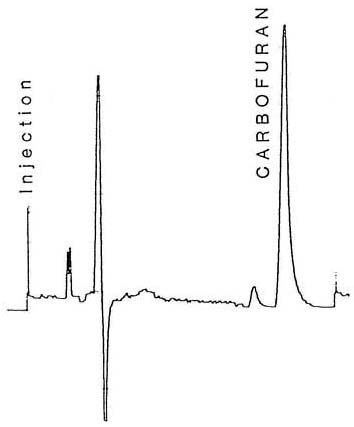1. General Discussion
1.1 Background
1.1.1 History of procedure
This evaluation was undertaken to determine the effectiveness
of the OVS-2 tube as a sampling device for carbofuran. It follows the
procedure developed for carbaryl. (Ref.
5.1)
1.1.2 Toxic effects (This section is for information
only and should not be taken as the basis of OSHA policy).
The
toxic effects of carbamate pesticides parallel those of
organophosphorus pesticides. Both classes of compounds inhibit
cholinesterase, thereby allowing the accumulation of large amounts of
acetylcholine. The major difference being that this inhibition is
reversible for carbamates and irreversible for organophosphates. (Ref.
5.2)
The following paragraph describing the results of
this cholinesterase inhibition is excerpted from the book OCCUPATIONAL DISEASES, A Guide To Their
Recognition and is applicable to both carbamates and
organophosphates. (Ref.
5.2)
When a critical level of
cholinesterase depletion is reached, usually about 20% of normal,
symptoms and signs of acetylcholine accumulation poisoning become
manifest. Symptoms may include blurred vision, weakness, nausea,
head- ache, abdominal cramps, chest discomfort, and diarrhea. Signs
may include miosis, muscle twitching, salivation, sweating, tearing,
cyanosis, convulsions, and coma. Carbamate pesticides can have low oral LD50s,
but in general their dermal LD50s are higher than other
cholinesterase inhibiting pesticides, such as
organophosphates.
Carbofuran has an acute oral LD50,
0 of 8 to 9 mg/kg for rats and an acute dermal LD50 of
10,200 mg/kg for rabbits. (Refs.
5.3-5.4)
In addition, carbofuran is highly toxic by the
inhalation route with significant cholinesterase depression in the
Rhesus monkey at 0.86 mg/m3 for a 75% wettable powder. (Ref.
5.3)
Due to these factors carbofuran has been given a TLV-TWA
of 0.1 mg/m3 by the ACGIH. (Ref.
5.3)
OSHA adopted this same value as its PEL in March 1989.
Editorial Note: These March 1989 PELs were vacated on July 7, 1992
and ceased to be enforceable on March 23, 1993 (FR
58:35338-35351, 6/30/1993).
1.1.3 Potential workplace
exposure
No estimate of worker exposure to carbofuran could be
found. Carbofuran is used as an insecticide. (Ref.
5.4)
1.1.4 Physical properties (Ref.
5.3-5.5)
| Molecular weight: |
221.26 |
| Molecular formula: |
C12H15NO3 |
| CAS #: |
1563-66-2 |
| IMIS #: |
0526 |
| Melting point: |
150 to 152°C |
| Vapor Pressure: |
0.0027 Pa (0.00002 mm Hg) at
33°C |
| Appearance: |
white crystalline solid |
| Solubility: |
700 ppm in water at 25°C unstable in
alcohols |
| Synonyms: |
Bay 70143, Crisfuran, Curaterr, D
1221, ENT 27164, FMC 10242, Furadan, NIA 10242, Pillarfuran,
Yalox |
| Chemical name: |
2,3-Dihydro-2,2-dimethyl-7-benzofu-
ranyl- methylcarbamate |
| UV spectrum: |
See Figure
1. |
| Structure: |
 |
| |
| | 1.2 Limit defining parameters
The detection limit
of the analytical procedure is 3.1 ng per injection. This is the
amount-of analyte which will give a peak whose height is approximately
five times the baseline noise. 2.
Sampling Procedure
2.1 Apparatus
2.1.1 A personal sampling pump that
can be calibrated to within
±5% of the recommended flow rate with
the sampling device in line.
2.1.2 OVS-2 tubes, which are
specially made 13-mm o.d. glass tubes that are tapered to 6-mm o.d.
They are packed with a 140-mg backup section and a 270-mg sampling
section of cleaned XAD-2. The backup section is retained by two foam
plugs and the sampling section is between one foam plug and a 13-mm
diameter glass fiber filter. The glass fiber filter is held next to
the sampling section by a poly-tetrafluoroethylene (PTFE) retainer.
(See Figure
2.) 2.2 Reagents
No
sampling reagents are required.
2.3 Sampling technique
2.3.1 Attach the small end of the
OVS-2 sampling tube to the
sampling pump with flexible, plastic
tubing such that the large, front section of the sampling tube is
exposed directly to the atmosphere. Do not place any tubing in front
of the sampler.
2.3.2 Attach the sampler vertically (large end
down) in the worker's breathing zone in such a manner that it does not
impede work performance.
2.3.3 After sampling for the
appropriate time, remove the sampling device and seal the tube with
plastic end caps.
2.3.4 Wrap each sample end-to-end with an
OSHA seal (Form 21).
2.3.5 Submit at least one blank with each
set of samples. Handle the blank the same as the other samples but do
not draw air through it.
2.3.6 Submit any bulk samples in
a separate container. Do not ship them with the air samples.
2.4 Extraction and desorption
efficiencies
2.4.1 Glass fiber filter
Six
13-mm glass fiber filters were placed in separate 4-mL vials. Five of
these filters were each liquid spiked with 26 µL of a 1.84 mg/mL
solution of carbofuran in acetonitrile. These six vials were then
sealed with PTFE-lined septa and stored overnight, in a drawer at room
temperature. They were then extracted with 2.0 mL of acetonitrile and
analyzed as in Section 3.5.
Table
2.4.1
Glass Fiber Filter Extraction Study
|
|
| Filter # |
Amount Spiked |
Amount Recovered |
%
Recovery |
|
| F1 |
47.84 µg |
47.12 µg |
98.5 |
|
| F2 |
47.84 µg |
47.12 µg |
98.5 |
|
| F3 |
47.84 µg |
47.46 µg |
99.2 |
|
| F4 |
47.84 µg |
48.56 µg |
101.5 |
|
| F5 |
47.84 µg |
47.12 µg |
98.5 |
|
| F6 |
0.00 µg |
0.00 µg |
Blank |
|
|
| Average
recovery is 99.2% |
2.4.2 XAD-2 adsorbent
An amount of XAD-2
adsorbent equal to the sampling section (270 mg) of an OVS-2 tube was
placed in each of six 4-mL vials which were then sealed with
PTFE-lined septa. Five of these vials were then each liquid spiked
with 26 µL of a 1.84 mg/mL solution of carbofuran in acetonitrile by
injecting the solution onto the adsorbent through the septum. After
replacing the punctured septa, these vials were allowed to equilibrate
overnight in a drawer at room temperature. They were then desorbed
with 2.0 mL of acetonitrile and analyzed as in Section 3.5.
Table
2.4.2
XAD-2 Adsorbent Desorption Study
|
|
| Adsorbent# |
Amount spiked |
Amount recovered |
% Recovery |
|
| AD1 |
47.84 µg |
45.69 µg |
95.5 |
| AD2 |
47.84 µg |
45.69 µg |
95.5 |
| AD3 |
47.84 µg |
45.69 µg |
95.5 |
| AD4 |
47.84 µg |
45.69 µg |
95.5 |
| AD5 |
47.84 µg |
46.40 µg |
97.0 |
| AD6 |
0.00 µg |
0.00 µg |
Blank |
|
| Average
recovery is 95.8% | 2.5 Retention efficiency
Six OVS-2 tubes were
each liquid spiked with 26 µL of a 1.84 mg/mL solution of carbofuran in
acetonitrile by spiking the glass fiber filter. These tubes were then
sealed with plastic end caps and placed in a drawer at room temperature.
After overnight storage, 480 liters of humid air (approximately 70%
relative humidity) were drawn through each tube. Three of these tubes,
along with a blank tube, were then desorbed and analyzed as in Section
3. No carbofuran was recovered from the backup section of these
tubes.
Table
2.5
Retention Efficiency Study
|
|
| Tube # |
Amount spiked |
Amount recovered |
% Recovery |
|
| RET1 |
47.84 µg |
45.16 µg |
94.4 |
| RET2 |
47.84 µg |
45.64 µg |
95.4 |
| RET3 |
47.84 µg |
45.93 µg |
96.0 |
| RET4 |
0.00µg |
0.00 µg |
Blank |
|
| Average
recovery 95.3% |
2.6
Sample storage
The remaining three spiked tubes from Section 2.5
(and a blank tube) were stored for a total of 7 days in a drawer at room
temperature. They were then desorbed and analyzed as in Section 3. No
carbofuran was recovered from the backup section of these tubes.
Table
2.6
Storage Study
|
|
| Tube # |
Amount spiked |
Amount recovered |
%
Recovery |
|
| ST1 |
47.84 µg |
48.51 µg |
101.4 |
|
| ST2 |
47.84 µg |
44.40 µg |
92.8 |
|
| ST3 |
47.84 µg |
46.79 µg |
97.8 |
|
| ST4 |
0.00 µg |
0.00 µg |
Blank |
|
|
| Average
recovery is 97.3% |
2.7
Recommended air volume and sampling rate
2.7.1 The recommended air volume is
480 L.
2.7.2 The recommended flow rate is 1.0
L/min. 2.8 Interferences
(sampling)
It is not known if any compounds will interfere with
the collection of carbofuran. Suspected interferences should be reported
to the laboratory with submitted samples.
2.9 Safety precautions
(sampling)
2.9.1 Attach the sampling equipment in
such a manner that it will not interfere with work performance or
employee safety.
2.9.2 Follow all safety practices that apply
to the work area being sampled. 3. Analytical Procedure
3.1 Apparatus
3.1.1 An HPLC equipped with a UV
detector, and a manual or automatic injector. A Waters 510 pump,
Waters 712 autosampler and Waters 490E UV detector were used in this
evaluation.
3.1.2 An HPLC column capable of separating
carbofuran from any interferences. A (25 cm x 4.6 mm i.d.) Chromasil
C18 (5 micron) column was used in this
evaluation.
3.1.3 An electronic integrator or other suitable
means of measuring detector response. A Hewlett-Packard 3357 data
system was used in this evaluation.
3.1.4 Vials, 4-mL glass
with PTFE-lined septa.
3.1.5 Volumetric flasks, pipets, and
syringes. 3.2 Reagents
3.2.1 Acetonitrile, HPLC
grade.
3.2.2 Water, HPLC grade. A Millipore Milli-Q system was
used to prepare the water in this evaluation.
3.2.3 Carbofuran.
A 99.6% pure standard from EPA was used in this evaluation.
3.3 Standard preparation
Prepare
stock, standard solutions by adding acetonitrile to preweighed amounts
of carbofuran. Prepare working range standards by diluting stock
solutions with acetonitrile. Store stock and dilute standards in a
freezer.
3.4 Sample preparation
3.4.1 Transfer the 13-mm glass fiber
filter and the 270-mg sampling section of the OVS-2 tube to a 4-mL
vial. Place the first foam plug and the 140-mg backup section in a
separate vial. A small glass funnel can be used to facilitate the
transfer of the adsorbent. Discard the rear foam plug. Do not discard
the glass sampling tube; it can be reused.
3.4.2 Add 2.0 mL of
acetonitrile to each vial.
3.4.3 Seal the vials with PTFE-lined
septa and allow them to desorb for one hour. Shake the vials by hand
periodically during the one hour desorption time.
3.5 Analysis
3.5.1 Liquid chromatographic
conditions
| Column: |
25 cm x 4.6 mm i.d. stainless steel
column packed with 5 micron Chromasil C18 |
| Mobile Phase: |
25% acetonitrile / 75% water |
| Flow rate: |
1 mL/min |
| UV detector |
210 nm |
| Retention time: |
13 min |
| Injection volume: |
10 µL |
3.5.2 Chromatogram (See Figure
3.) 3.6 Interferences
(analytical)
3.6.1 Any compound having a retention
time similar to that of the analyte is a potential interference.
Generally, chromatographic conditions can be altered to separate
interferences from the analyte.
3.6.2 Retention time on a
single column is not proof of chemical identity. Analysis by an
alternate HPLC column, detection at another wavelength (for comparison
of absorbance response ratios) and confirmation by mass spectrometry
are additional means of identification. 3.7 Calculations
3.7.1 Construct a calibration curve by
plotting detector response versus standard concentration.
3.7.2
Determine the concentration of carbofuran in each sample from the
calibration curve. If carbofuran is found on the backup section, make
blank corrections for each section separately before adding the
results together.
3.7.3 Determine the air concentration by the
following formula.
| mg/m3 = |
(µg/mL in sample) x (desorption
volume, mL)
(air volume, L) x (desorption efficiency, decimal)
| 3.8 Safety
precautions (analytical)
3.8.1 Avoid exposure to all standards.
3.8.2 Avoid exposure to all solvents.
3.8.3 Wear safety
glasses at all times. 4. Recommendations for Further Study
4.1 Even though the UV spectrum
indicates higher absorbance at either
280 nm or 230 nm (See Figure
1), 210 nm was a more sensitive wavelength for the analysis of
carbofuran. This behavior should be investigated further. For example,
analysis on a diode array UV detector to determine the most sensitive
analytical wavelength.
4.2 A desorption study determining the
recovery from a 13-mm glass fiber filter in combination with 270 mg of
XAD-2 should be done. This is the desorption efficiency used in Section
3.7.3.
4.3 The literature indicates that carbofuran is unstable
in alcohols. It was observed in the HPLC analysis of a carbofuran
standard in acetonitrile that the analyte peak got smaller and a
secondary peak grew in size. This did not occur until after several
weeks at room temperature. Carbofuran appears stable enough in
acetonitrile but this slow decomposition with time should be kept in
mind.
4.4 This method should be fully validated.

Figure
1. UV Spectrum of Carbofuran in the HPLC Mobile
Phase. |

Figure 2.
OVS-2 Sampling Device |

Figure 3.
Chromatogram of Carbofuran | 5. References
5.1. Burright, D.; Method #63,
"Carbaryl"; OSHA Analytical Laboratory, unpublished, 1987.
5.2.
"OCCUPATIONAL DISEASES, A Guide to their Recognition"; U.S. Department
of Health, Education, and Welfare; Public Health Service, Public Health
Service Publication No. 1097, U.S. Government Printing Office:
Washington, D.C., 1964; p 245.
5.3. "Documentation of the
Threshold Limit Values and Biological Exposure Indices", 5th ed.;
American Conference of Governmental Industrial Hygienists: Cincinnati,
OH, 1986; p 100.
5.4. "Farm Chemicals Handbook"; Meister
Publishing Co.: Willoughby, OR, 1986; p C48.
5.5. Windholz, M.,
Ed.; "Merck Index", 10th ed.; Merck and Co.: Rahway, NJ, 1983; p
250. |

